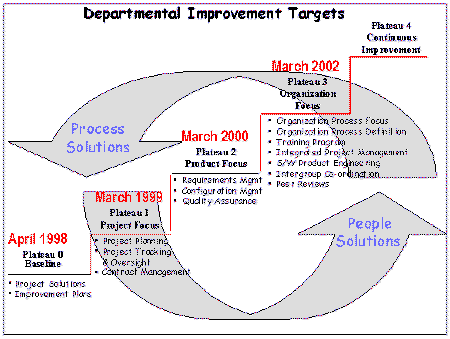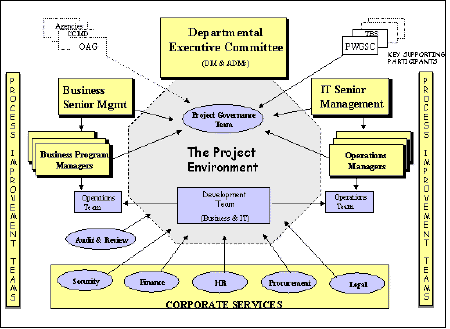Common menu bar links
Breadcrumb Trail
Institutional links
Chief Information Officer Branch
IT Project Review and Oversight
Enhanced Management Framework
ARCHIVED - An Enhanced Framework for the Management of Information Technology Projects - Part II Solutions: Putting the Principles to Work
 This page has been archived.
This page has been archived.
Archived Content
Information identified as archived on the Web is for reference, research or recordkeeping purposes. It has not been altered or updated after the date of archiving. Web pages that are archived on the Web are not subject to the Government of Canada Web Standards. As per the Communications Policy of the Government of Canada, you can request alternate formats on the "Contact Us" page.
3. Where to Start
Since the publication of the Enhanced Framework in May of 1996, departments have not been idle. Pilots have been conducted, assessments have been made, lessons have been learned, and goals have been defined for the implementation of improvements within IT/IM organizations.
What follows is a recommended strategy that will allow departments to integrate these plans with the requirements of the Enhanced Framework. This strategy contains:
- a step-wise approach and timeframes for implementation;
- an outline of the activities at each stage;
- a brief description of the roles and responsibilities of the players required for successful implementation;
- a description of solutions/approaches/methods available from Treasury Board Secretariat that will be of assistance to departments during implementation; and
- a broad outline of the initial tasks required to get started.
3.1 Departmental Improvement Plateaux
It is understood that departments are not beginning implementation of the Enhanced Framework from a standing start. Some departments have already launched IT process improvement initiatives. The chart below, however, provides the larger government-wide view of implementation and the steps that departments are expected to have either underway or completed.

Figure 2 – Departmental Improvement Plateaux
Organizations cannot be improved overnight. These improvements require time, dedication and perseverance. Plateau 0 provides departments with the opportunity to immediately implement specified solutions within projects that will increase the likelihood for their success. It also gives departments the impetus to plan the strategy, tactics and implementation approach for the next four Plateaux.
Plateaux 1 and 2 address project processes that must exist for practices to be repeatable and project outcomes to be predictable. These processes must be in place and effectively performed if project teams are expected to deliver quality products.
Plateaux 3 and 4 address the broader organizational processes that must exist for projects to be consistently successful over the longer term. Improvements to key areas are cyclical in nature, with improvements planned, implemented, reviewed and then built upon.
Details of the goals to be met for Plateaux 0-4 can be found in Appendix 2
The Departmental Improvement Plateaux do not dictate the approach to be used by departments to improve but rather focuses on the concrete steps towards the ultimate goal of significantly improving the government's ability to deliver and manage IT projects. Developed independently from any methodology or improvement model, this path reflects the initial Enhanced Framework findings and the priorities of government departments.
Plateau 0: Baseline
This first Plateau is designed to ensure that departments have in place the basic project solutions required to initiate and manage a project. These include defining a clear and explicit business case, a procurement strategy, a project charter; a gating and review process; a project planning and control mechanism and a risk management approach.
The second objective of Plateau 0 is to ensure that departments create a plan for advancing to the next Plateau. Without a plan, it is unlikely that departments will make the improvement gains as identified in the Enhanced Framework. It is expected that by March of 1998, departments will have implemented the basic project solutions and created their plans for achieving their next Plateau.
Plateau 1: Project Focus
Project planning, tracking and oversight, and contract management (if applicable) begin once a project has been approved and initiated. While most departments already have processes in place that address these functions, the achievement of Plateau 1 will ensure that there are no gaps or weaknesses. The objective of this plateau is to achieve proper planning for projects in government departments and to establish sufficient visibility into actual progress to allow senior management to take effective action when the project deviates from plan. It is also in Plateau 1 that actions are taken to ensure project managers have the required knowledge and experience and the tools to support them and the project. Departments are to have implemented these improvements by March of 1999, and have a plan in place to move to their next Plateau.
Plateau 2: Product Focus
Plateau 2 seeks to establish, at a project level, consistent and effective controls and processes that when followed will ensure:
- changes to requirements follow a clearly defined effective change management process;
- product integrity is maintained throughout the life of the project; and
- product quality is acceptable within defined parameters.
Again, many departments have processes in place and achieving this Plateau will ensure that elimination of any gaps or weaknesses. Actions continue to be taken to ensure plans are in place for addressing Plateau 3 and that the project management training and education activities (professional development) continue.
Plateau 3: Organizational Effectiveness
The third Plateau deals with making the processes and practices established in Plateaux 0-2 the way that government departments do business for all their projects. The objective of this Plateau is to ensure that the best processes implemented in one project within a department are carried through to the other projects within the organization. Organization-wide issues such as the training of personnel and the documentation of processes are also addressed at this level.
Plateau 4: Continuous Improvement
The final Plateau deals with improving the organizational effectiveness of departments on a continuous basis when managing and delivering projects (e.g. deliver projects faster, better, cheaper). This Plateau includes quantitative techniques to measure processes, and proactive activities to streamline and improve these and other existing practices.
This path for improvement will guide Enhanced Framework implementation by establishing clear priorities, objectives and time frames.
3.2 Departmental Implementation Responsibilities
It is expected that all departments will be familiar with and committed to the implementation of the both the precepts and the solutions associated with the Enhanced Framework by March of 1998. Such a commitment will place the Enhanced Framework as a priority item on departmental action agendas.
The diagram below depicts those who have a major role to play in the implementation of the Enhanced Framework. This diagram does not depict every player in every circumstance. Rather it is an attempt to portray a generic situation. Departments are expected to adapt this portrayal to their own unique and individual circumstances.
All of the players depicted are key to the successful implementation of the Enhanced Framework. Failure on the part of any player to actively support and/or participate in its implementation will likely result in failure of the whole.
Figure 3: Key Departmental Participants in Implementation
Each group will support the implementation of the Enhanced Framework in the follow ways:
Departmental Executive Committees:
- Communicate the critical need for change
- Explicitly endorse and mandate the Enhanced Framework
- Assign responsibility and ensure compliance
- Harvest and leverage the benefits
Business Senior Management:
- Actively support Senior Management in their desire to implement the Enhanced Framework and communicate the need for change
- Assume the role of Project Sponsor
- Actively participate in the decision making process for business issues which affect the project
- Actively participate on the Project Governance Team
- Assign responsibility and resources for implementation of the Enhanced Framework elements that affect their environment
- Leverage and harvest the benefits of implementation
IT Senior Management Team
- Champion and commit to implementation of the Enhanced Framework
- Actively communicate the need for change and progress being made
- Assign resources
- Actively participate on the Project Governance Team
- Manage the boundaries between IT, the Business Units and Corporate Services
Project Governance Team
- Use the Enhanced Framework solutions tailored for their situation
- Ensure compliance with the Framework
- Communicate successes and 'best practices' developed
- Acquire new knowledge as appropriate
- Work together as a team in mutually supportive and explicitly defined roles
- Assist and advise project partners
- Liaise with the process team
Process Improvement Team
- Modify and tailor improvement processes to include Enhanced Framework
- Create the stimulus for improvement
- Set content and establish sponsorship
- Define the management process
- Design the measurement process
- Implement the change
- Gather metrics
- Demonstrate and publicize progress
Business Program Managers/ IT Operations Managers
- Understand the Enhanced Framework and apply as required
- Assign resources to the project and process teams
- Actively participate on the Project Governance Team as required
The Project Development Team
- Use the Enhanced Framework and it solutions
- Institute a program of risk management for the project
- Report progress accurately and timely
Audit and Review
- Audit IT projects against the precepts and concepts of the Enhanced Framework
- Provide feedback into the Framework to ensure that it continues to develop and reflect departmental needs
- Provide assurance on the adequacy and cost effectiveness of controls being built into the product
Corporate Services
- Modify policies, practices and procedures to reflect key concepts of the Enhanced Framework, where required
- Ensure contractual resources on the Project Development Team comply with the Framework
- Actively participate on the Project Governance Team when required
- Support the project through resourcing, procurement, finance, legal and security
3.3 Implementation Responsibilities for Key Supporting Participants
Key supporting participants are a diverse group whose role is to support the project, the department and/or each other in the implementation of the Enhanced Framework. For discussion purposes, the roles of these participants are treated as mutually exclusive. As well, no attempt has been made to identify every possible participant, as this will depend on the nature of the specific project. Instead, the implementation responsibilities of a representative sample are provided.
PWGSC (primarily Procurement: Science, Informatics and Professional Service Sector & Major Crown Projects Service Lines)
- Modify policies, practices and procedures to align with the Enhanced Framework
- Ensure contractual resources on the Project Development comply with the Enhanced Framework
PWGSC (The Institute)
- Modify training offerings to comply with the Enhanced Framework
- Schedule and deliver training for project sponsor, project leader and project manager
- Maintain an inventory of all project managers
TBS
- Align policies with the Enhanced Framework
- Apply the concepts of the Enhanced Framework against the submission process
- Facilitate implementation of the Enhanced Framework through strategic relationship building and the provision of support
- Provide increased levels of authority to departments where sustained compliance with the Framework has been demonstrated
Office of the Auditor General
- Audit IT projects against the precepts and concepts of the Enhanced Framework
- Recognize those departments who have implemented the Enhanced Framework and have learned from those experiences
- Provide feedback into the Framework to ensure that it continues to develop and reflect government needs
Canadian Centre for Management Development
- Build the Enhanced Framework into executive training
- Schedule the Project Sponsor and Project Leader symposia

